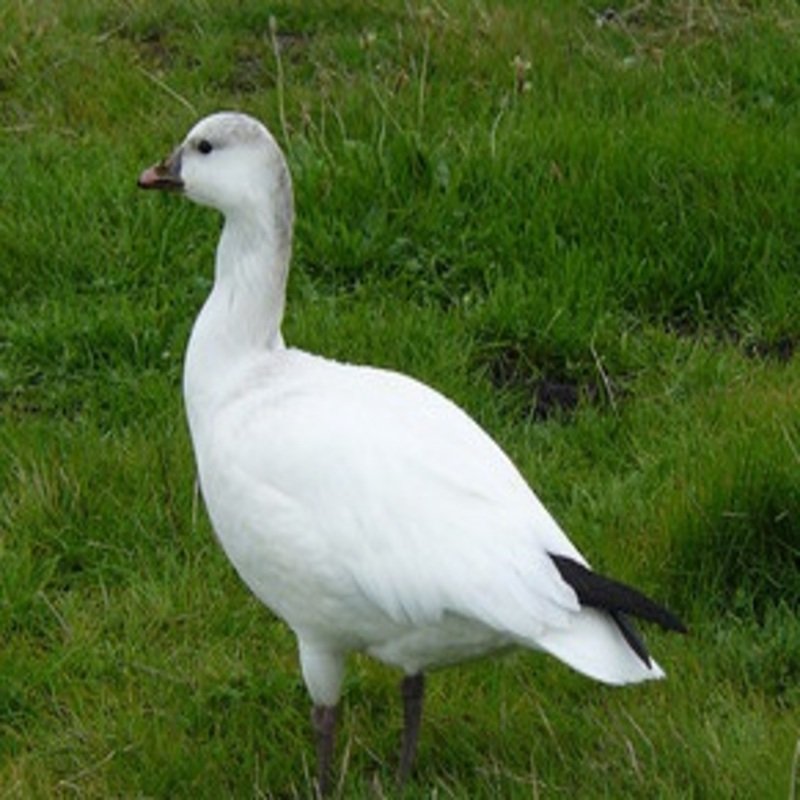Ross’s geese, Anser rossii in Latin, is a little white bird with black wingtips and a short neck. It is the smallest of the three North American “white geese.” It resembles a white-phase snow goose but is roughly 40% smaller. Additionally, the snow goose’s bill is thinner in proportion to its body and it lacks “black lips.” The dark phase is exceedingly uncommon.
Quick Overview: Anser Rossii – Ross’s Geese
Body size: Around 21-26 in (53-66 cm) and a weight of 1678 g (59.2 oz)
Main colors: White, Black, Red-orange, Gray
Range: Central United States
Migratory Bird: Yes
Best time of the year to see in the U.S.: March, April, May, September, October, November
Conservation Status: Least Concern
Ross’s Geese Description
Small white goose with black primary feathers and a short red-orange beak with a gray base. Legs and feet in a red-orange hue.

Size
These birds have a length of 21-26 in (53-66 cm) and a weight of 1678 g (59.2 oz). Their wings could range from 47-54 in (119-137 cm).
Feeding
Ross’s Geese feed on plant material and only seldom on insects. They feed mostly on grass and sedge roots when they arrive on mating grounds, just as the tundra begins to thaw. They feed on cottongrass, birch, and sedge shoots throughout the season.
Habitat
Ross’s Geese breed exclusively in Canada, breeding in dry, low-arctic tundra, typically near regions with abundant sedges and grasses, and frequently on islands of dwarf birch and willow in tiny lakes.
Behavior
Ross’s stay at marshes and agricultural fields during the fall migration, where they eat barley, wheat, field peas, and wheatgrass. Ross’s Geese breed exclusively in Canada, breeding in dry, low-arctic tundra, typically near regions with abundant sedges and grasses, and frequently on islands of dwarf birch and willow in tiny lakes.
Anser Rossii Scientific Classification
- Kingdom: Animalia
- Phylum: Chordata
- Subphylum: Chelicerata
- Class: Aves
- Order: Anseriformes
- Family: Anatidae
- Genus: Anser
- Species: Anser rossii
Best time of the year to see
In the United States, the best time of year to see these birds are during the Spring season (March-May) and during the Autumn season (September – November).
Distribution of the Ross’s Geese in the USA
Breeds on the tundra in far northern Canada’s coastal regions and on Southampton Island in Hudson Bay. Winters in California and, to a lesser extent, the lower Mississippi Valley, the east coast, and the Gulf Coasts of Texas, Mexico, and the Yucatan Peninsula.
The Ross’s Geese can be found in the following states in the United States – Alabama, Alaska, Arizona, Arkansas, Colorado, Connecticut, Delaware, Florida, Georgia, Hawaii, Idaho, Illinois, Iowa, Kansas, Kentucky, Louisiana, Maine, Maryland, Massachusetts, Michigan, Minnesota, Missouri, Montana, Nebraska, Nevada, New Hampshire, New Jersey, New Mexico, North Carolina, North Dakota, Oklahoma, Oregon, Pennsylvania, Rhode Island, South Carolina, South Dakota, Tennessee, Utah, Vermont, Virginia, Washington, West Virginia, Wisconsin, and Wyoming.

